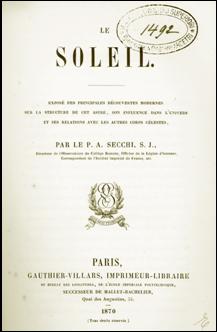Angelo Secchi
The Reverend Father Angelo Secchi Catholicism | |
|---|---|
| Awards | Légion d'honneur, France |
| Scientific career | |
| Fields | Astronomy |
| Institutions | Observatory of the Roman College |
Angelo Secchi
Biography
Secchi was born in
During his stay in America, he met Commander Matthew Fontaine Maury, the first director of the United States Naval Observatory in Washington. He studied with Maury and corresponded with him for many years.[2]
He returned to Rome in 1850. On the recommendation of his late colleague Francesco de Vico, he became head of the observatory of the college at age 32. In 1853, under his direction, the crumbling observatory was relocated to a new facility on top of the
Secchi was elected to the American Philosophical Society in 1860.[5]
His director position was challenged after 1870, when the remnant of the
He died in 1878 at age 59, in Rome.
Astronomical works

Secchi made contributions to many areas of astronomy.
- He revised Friedrich Georg Wilhelm von Struve's catalog of double stars, compiling data for over 10,000 binaries.
- He discovered three comets, including Comet Secchi.
- He produced an exact map of the lunar crater Copernicus.
- He drew some of the first color illustrations of Mars and was the first to describe "channels" (canali in Italian) on the planetary surface.[6]
- The first star recognized as a Be star was Gamma Cassiopeiae, which Secchi observed in 1866; the first star ever observed with emission lines.[7]
Secchi was especially interested in the Sun, which he observed continually throughout his career.
- He observed and made drawings of solar eruptions and sunspots, and compiled records of sunspot activity.
- In 1860 and 1870, he organized expeditions to observe solar eclipses.
- He proved that the solar coronaand coronal prominences observed during a solar eclipse were part of the Sun, and not artifacts of the eclipse.
- He discovered solar spicules.
However, his main area of interest was
Starting in 1863, he began collecting the spectra of stars, accumulating some 4,000 stellar spectrograms. Through analysis of this data, he discovered that the stars come in a limited number of distinct types and subtypes, which could be distinguished by their different spectral patterns. From this concept, he developed the first system of
Other scientific and technical work
Secchi was active in oceanography, meteorology, and physics, as well as astronomy.
He invented the
Secchi also performed related technical works for the Papal government, such as overseeing placement of sundials and repair or installation of municipal water systems. In 1854–1855, he supervised an exact survey of the Appian Way in Rome. This survey was later used in the topographic mapping of Italy. He supervised construction of lighthouses for the ports of the Papal States. In 1858, he traveled to France and Germany to procure the necessary projection lenses.
Heritage

The lunar crater
The two STEREO (Solar TErrestrial RElations Observatory) spacecraft each carry an instrument package called SECCHI (Sun Earth Connection Coronal and Heliospheric Investigation).
See also
- List of Jesuit scientists
- List of Roman Catholic scientist-clerics
Works (incomplete)

During his career, Fr. Secchi published about 730 papers in scientific journals. He also published a number of books.
- Misura Della Base Trigonometriea Eseguita Sulla Via Appia (Measurement of the Trigonometric Base Performed On the Via Appia). Rome. 1858.
{{cite book}}: CS1 maint: location missing publisher (link) - Il Quadro Fisico del Sistema Solare Secondo le Piu Recenti Osservazioni (The Physical Framework of the Solar System According to the Most Recent Observations). Rome. 1859.
{{cite book}}: CS1 maint: location missing publisher (link) - Secchi, Angelo (1861). Sui recenti progressi della meteorologia. Roma: Tipografia delle Belle Arti.
- Sulla Unitá delle Forze Fisiche (On the Unity of Physical Forces). Rome. 1864.
{{cite book}}: CS1 maint: location missing publisher (link) - Unità delle forze fisiche (in Italian). Roma: Tipografia Forense. 1864.
- Le Soleil: Exposé des Principales Découvertes Modernes (The Sun: Presentation of the Major Modern Discoveries). Paris. 1870.
{{cite book}}: CS1 maint: location missing publisher (link) - Secchi, Angelo (1871). Rapporto della commissione per la misura del meridiano centrale europeo negli Stati Pontifici. Roma: Tip. delle scienze matematiche e fisiche.
- Stelle (in Italian). Milano: Dumolard. 1877.
- Lezioni elementari di fisica terrestre (in Italian). Torino: Loescher. 1879.
References
- Congregation for the Doctrine of the Faith also states 28 June as his birthday in a biographical article in La Civiltà Cattolica.
- ^ a b c Pohle 1912.
- ^ Chisholm 1911.
- ^ Voelkel, James R. (2016). "Saw the Light: The early days of spectroscopy". Distillations. 2 (1): 24–25.
- ^ "APS Member History". search.amphilsoc.org. Retrieved 14 January 2021.
- ISBN 0-521-63280-3.
- .
- Attribution
- Chisholm, Hugh, ed. (1911). . Encyclopædia Britannica. Vol. 24 (11th ed.). Cambridge University Press. p. 568.
- Pohle, Joseph (1912). . Catholic Encyclopedia. Vol. 13.
Sources
- Maffeo, Fr. Sabino, SJ (1991). In the Service of Nine Popes: 100 Years of the Vatican Observatory. trans. Fr. George Coyne, SJ. Città del Vaticano (Vatican City): Specola Vaticana. ISBN 88-7761-046-8.)
{{cite book}}: CS1 maint: multiple names: authors list (link
- Hentschel, Klaus (2002). Mapping the Spectrum. Techniques of Visual Representation in research and Teaching. Oxford: Oxford Univ. Press. ISBN 9780198509530.
- Chinnici, Ileana; Gargano, Mauro, eds. (2018). "Tra cielo e Terra: L'avventura scientifica di Angelo Secchi". Roma: Comitato Nazionale per il Bicentenario della Nascita di Angelo Secchi. Archived from the original on 26 May 2019. Retrieved 26 May 2019.
- Chinnici, Ileana (2019). Decoding the Stars: A Biography of Angelo Secchi, Jesuit and Scientist. Leiden/Boston: Brill. ISBN 9789004387331.
External links
 Works by or about Angelo Secchi at Wikisource
Works by or about Angelo Secchi at Wikisource
